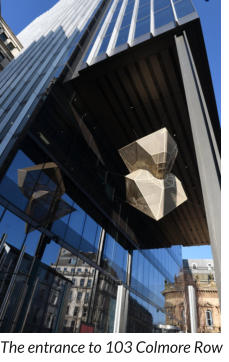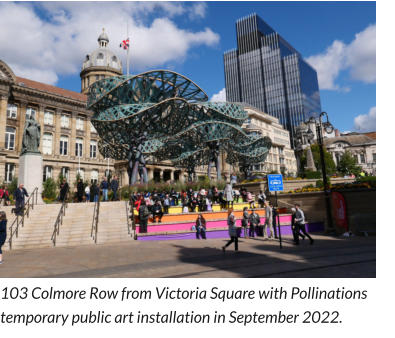Public Art of 103 Colmore Row
Modern Birmingham is certainly epitomised by the huge glass-clad 103 Colmore Row sitting proudly on top of the city centre skyline. This new office block replaced John Madin’s 1975 NatWest tower, demolished after less than fifty years. This is so much the Birmingham way, though increasingly questions are asked about the green- washing arguments for continuing large-scale demolition, rather than refurbishing our brutalist concrete heritage. At the top of this new and even taller tower, is Orelle restaurant, with amazing views out across the city. Look carefully and you can see the planes taking off from Birmingham airport, where they appear like children’s toys on the horizon. Certainly worth a visit when you have something to celebrate.Public art of significance
However, with all this modernity 103 Colmore Row includes two significant installations which, in different ways, demonstrate the depth of Birmingham’s Public Art and the history of this place. Consider first the new public art feature to the left of the grand four- story modernistic colonnaded entrance. Equinox is the final work of Wolverhampton artist and sculptor John Pickering. Indeed, the work was completed after his death with John having presented initial ideas for the public sculpture at a first meeting with the architects and developer. He died just a week before a second meeting was due to be held. The ideas for this large scale interpretation of John’s art form were taken to completion by John’s friend and collaborator George L. Legendre, along with the architects Doone Silver Kerr and with the support of the developers Sterling Property Ventures and Tristan Capital Partners .Inversion Principle
John Pickering trained initially at the Bilston College of Art then came to Birmingham School of Art where his lecturers included William Bloye. John went on to work as a stone carver on St Philip’s Cathedral and then at the Collegiate Church of St Mary in Warwick and for a time working in a wood pattern-making factory. From the 1970s John turned to using mathematical spatial transformations to produce geometric 3-d sculptures using the inversion principle. In 2002 John’s inversion principle based sculptures were exhibited in London at the Royal Society of British Sculptor. From this time John began a working relationship with George L. Legendre whose interest in computerised mathematical modelling complemented John’s artistic application of the inversion principle. Equinox is the only large in scale public sculpture produced from John’s ideas. It is constructed from solid steel tubing with laser cut flat metal sheets, and weighs over 1.5 tonnes. Equinox was fabricated by the firm Structural Stairways from Brierley Hill and there is an interesting video showing Equinox being made with key people visiting the factory (see link below).Inversion principle for beginners
In simple terms inversion is the reflection in a circle, where points inside and outside the circle are mapped and related to the circle’s radius by the equation: MP .MQ = r 2 Rearrangement, of the equation allows you to find the length MQ, by translating the equation to: MQ = r 2 /MP For his 3-d studies Pickering used the inversion of objects such as spheres rather than a 2-d circle. Things do of course get more complicated. If you are interested there is a very readable book that can gives you the detail and with photos of John’s models still available to buy (Mathematical Form; John Pickering and the architecture of the inversion principle, 2006). John used a calculator to hand produce the numbers for his designs with everything carefully written in columns in his notebooks and with a staggering number of decimal places. Today people taking John’s work forward would undoubtedly use relevant computer software and perhaps just two or three decimal places. The added value John gave was certainly less tangible, with the artistic interpretation of the maths becoming something that was certainly essential to form a piece of art.Birmingham exhibition
When Equinox was installed there was also an exhibition of some of John’s models. These were only going to be on display for a few months, but luckily the exhibition was extended and was still there to view when we visited in March 2023. Through his life John’s family had encouraged him in his work on inversion principle sculptures. Though produced as table top models, John certainly knew there was the potential to scale up his designs as larger sculptures. It is fitting that he was aware this was going to happen with Equinox before he died. Today the John Pickering Foundation works to create interest in John’s work, both by protecting his sculptures and ensuring they are seen by the public, and with aims to build on John’s ideas, and with it the possibility of seeing more larger scale works.Surprise on the way to the top
Why not arrive a little early for your high level meal at Orelle French restaurant. When you have taken a look at Equinox head to the lifts , then stay awhile. For you will go through the amazing doors of the former NatWest tower’s main bank entrance doors. These Henry Haig doors are in great condition and are situated to your left and right as you head to the lift. These are made in cast aluminium, but Henry also produced art pieces in concrete as well as other materials. He was also well known for his work in stained-glass ecclesiastical windows. Now this is Birmingham, and we are a can-do city. So if you want to see the NatWest doors more than just glimpsing in the windows from the street , just pop into Orelle and speak to the concierge, who may well let you spend a little time with them.Brutalist art in other parts of the city
Artistic additions to brutalist concrete art also became a speciality of William Mitchell , who came out of the Navy and trained at the Southern Art College in Portsmouth. The area of sculpture that he fell into and hit hard was using concrete designs to add interest to the brutalist concrete architecture.Hockley Flyover
The Climbing Frame (1968), under the Hockley Flyover sees three of the four pedestrian entrances having Mitchell’s public art pieces. In a rather unfashionable part of Birmingham these large scale installations were made by pouring concrete into wooden shuttering within which artistic moulds were placed. Once the moulds were removed the work was completed with some sand blasting and sealing. Considering the graffiti all around Climbing Frame these pieces are in remarkably good condition and are now afforded a degree of protection as they have been recently Grade II listed.Look up on Broad Street
Then on to the amazing panels on the first level of the John Madin designed Quayside Tower office block on Broad Street oppositive the International Convention Centre. When the author sent a photo of the Broad Street panels to Wiliam Mitchell in 2016 he remarked that they were in good condition for 1965 examples of his work. He suggested perhaps a light sand blasting but cheer them up but then went on to say they might be best left alone. He ended by asking if the office block was going to be knocked down. Birmingham is lucky to have such work of William Mitchell and it is hoped that those on Quayside Tower will be treated with a little more respect in the future as the legacy of Mitchell is increasingly important to both preserve and appreciate. Jonathan Berg, March 2023Credits & Further Reading
• Thanks to the John Pickering Foundation for permission to take photos of and reproduce here the models currently being shown at 103 Colmore Row. • John Pickering Foundation website: www.johnpickeringsculptor.com • 103 Colmore Row article on Equinox: www.103colmorerow.com/developers-create-lasting-legacy-for-local-artist-at- 103-colmore-row/ • Mathematical Form; John Pickering and the architecture of the Inversion Principle. 2006, Architectural Association. ISBN 1 902902 37 1. [New copies currently (March 2023) available from £10 from internet bookshops]
Kelvin Hamilton and colleagues from the Collaborative Research & Innovation
team at Autodesk, recently enjoyed visiting the John Pickering exhibition at 103
Colmore Row. In particular a work produced in partnership with the Special
Modelling Group of Fosters and Partners caught their eye. See more here…





The Making of Equinox
A 10 minute video which looks at the making of Equinox. Includes John’s twin brother Arthur and friend and working associate George L. Legendre. [Scroll down on landing page to get to video]



Equinox - see bottom of article for link to video
about the making of Equinox in Brierley Hill.
Underneath the Hockley Flyover are three large in scale poured in situ concrete artworks by William Mitchell.


The former National Westminster Bank entrance doors form an amazing walkway to the lift and on up to Orelle restaurant

Quayside Tower on Broad Street sees multiple pieces of public art by William Mitchell dating from 1965. The sooner they are
Grade II listed the better as at present a nightclub does not seem to understand their importance


www.birminghamspublic.art









